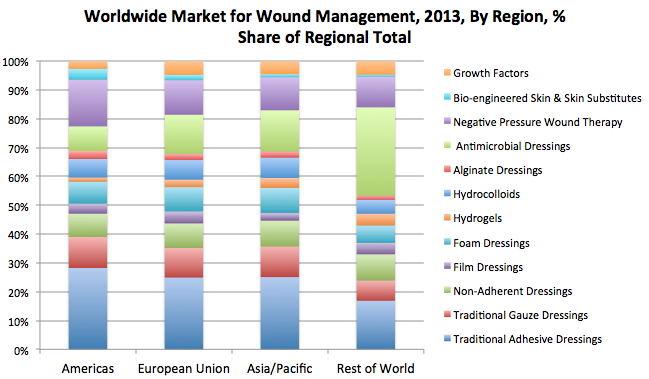Analysis is a funny thing. If done thoroughly, accurately and carefully to represent a subject from all relevant angles, it can reveal very important considerations by those with a vested interest (e.g., in support of expensive investment).
Analysis is a funny thing. If done thoroughly, accurately and carefully to represent a subject from all relevant angles, it can reveal very important considerations by those with a vested interest (e.g., in support of expensive investment).
Analysis is often driven by assumption. (“It seems to me that the relative significances of different wound management products vary from one country to another, or one region to another.”) So, analysts go looking for data that would support or reject that assumption. Here, one would be interested in the relative values of different wound product sales in different countries.
Ah, we have that data. Let’s plot the sales, as a percent of each region’s total, for the different categories of wound management products in the Americas, European Union, Asia/Pacific and Rest of World:
Source: MedMarket Diligence, LLC; Report #S249.
What striking results, the analyst says. Clearly, negative pressure wound therapy is much more common in the Americas than it is in the Rest of World. Other small-to-significant differences are seen in other product areas.
However, the better analyst would challenge the assumption or at least consider its relevance to important decisions (again, e.g., expensive investment).
This relative data was presented because it answered an assumption, that relative use of different wound management products varies by country/region. Of course, this is indeed true.
But that’s not the whole story. Here, we have engaged ourselves in a careful analysis of deck chairs on top of a magnificent, unsinkable luxury liner.
The bigger picture, the more relevant context into which this analysis must fit is not simply the relative difference, but the absolute difference. If we take this question of wound product sales by geography and consider not the relative but the absolute differences, the picture changes considerably:
Source: MedMarket Diligence, LLC; Report #S249.
Which analysis is correct? Of, course, they both tell the truth, but neither tells the whole truth. One can gain a more comprehensive understanding by considering both and recognizing the significance of actions based on one or the other analysis.
